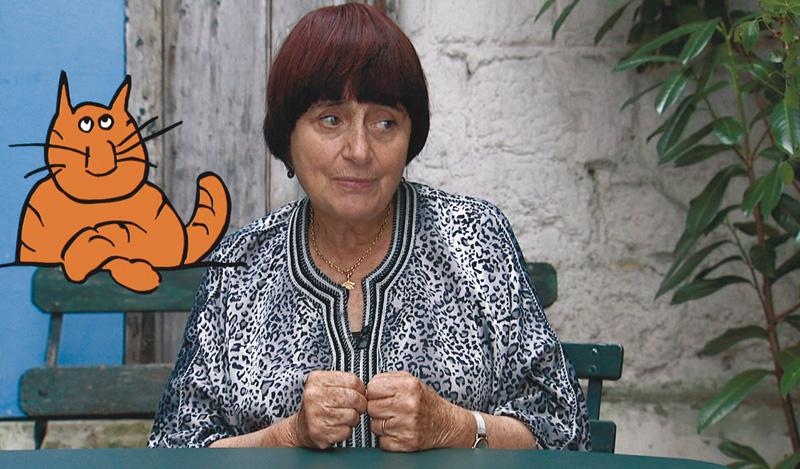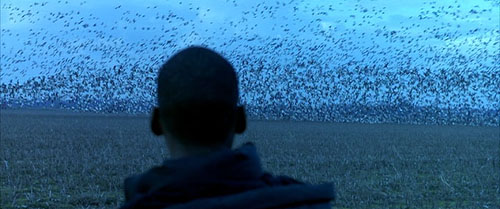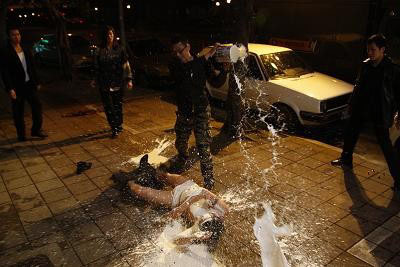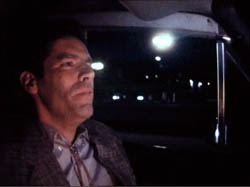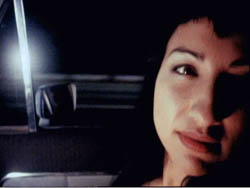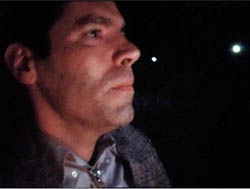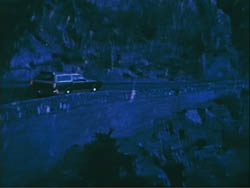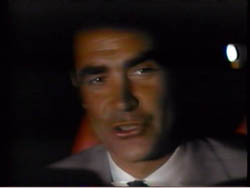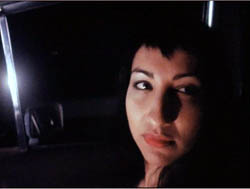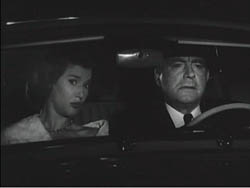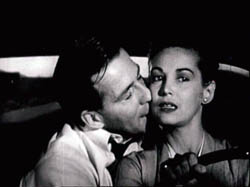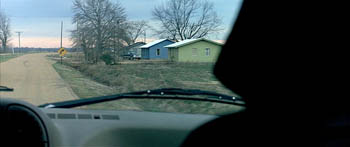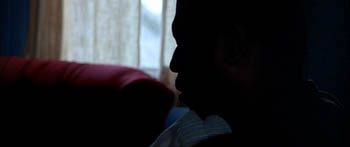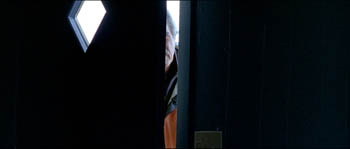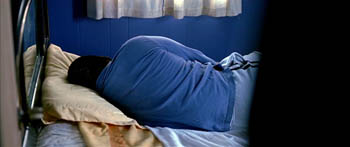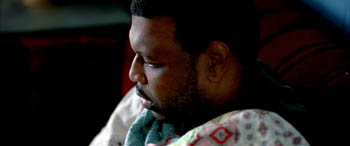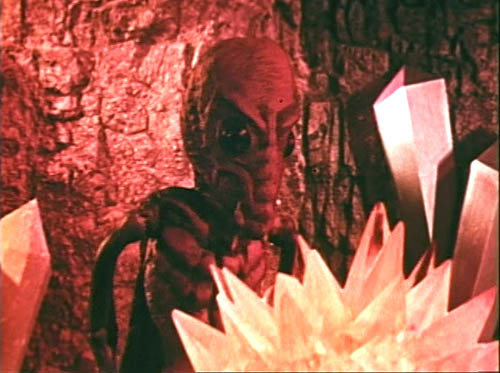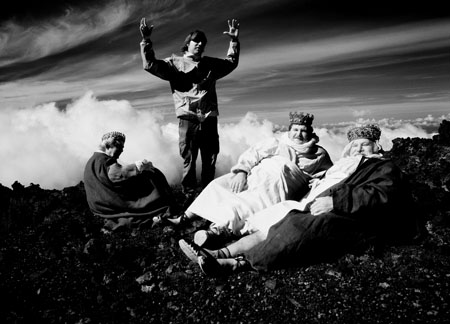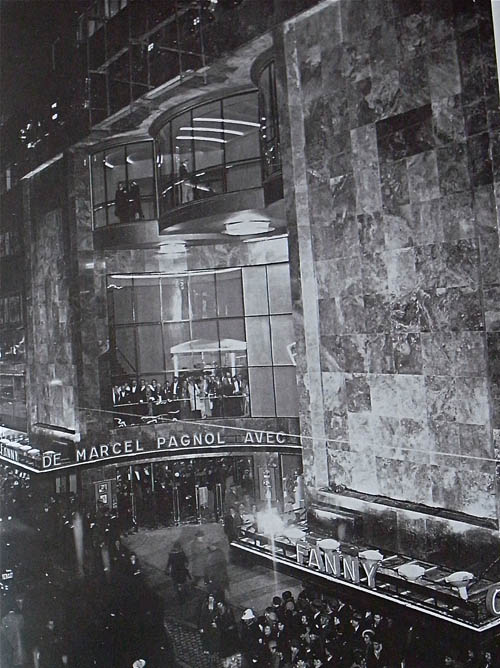Archive for the 'Independent American film' Category
Yes, we like it here at the Wisconsin Film Festival
Kristin here-
David has gone halfway around the world to attend a film festival and will be reporting more on what he sees in Hong Kong. But in Madison we have the Wisconsin Film Festival going on now, and there’s plenty to watch here as well, even if it’s only for four days rather than two weeks.
So far I have seen four films in two days and plan to see five more before the festival ends tomorrow night. That means that so far I’ve sat through the short festival prologue film that announces its sponsors four times. Each year we have a different little prologue film. This year director Meg Hamel and her team found a snappy promotional film for Wisconsin that looks like it was made in the late 1950s or early 1960s. Its slogan is “We like it here!” and it features not only our famous dairy and other farm products but also things which are fast disappearing from local industry–like cars and tractors. I’m not sure how I’ll feel about this little film after watching it nine times, but so far it’s amusing.
And our Wisconsin products have followed David to Hong Kong. Shopping for breakfast items in a local grocery store, he found some familiar fare:
We’ve served many a Johnsonville brat during our annual Labor Day cook-out. They look pretty good compared with the pale Chinese version juxtaposed in the photo. And a product from even closer to home, Bagels Forever bagels, which set up shop here in Madison a few years after we did:
Of course, we have Hong Kong imports here as well. I’ve got a ticket to see Johnnie To’s Sparrow tonight.
So far I’ve seen some excellent films. Agnès Varda’s The Beaches of Agnès was a salubrious way to start. It’s an autobiography of sorts, built around visits to the various seaside locales that have played a big part in her life, from childhood visits to the resorts of Belgium to an escape to Corsica to the fishing village that featured in her first film, the 1954 short feature La Pointe-courte to Venice in Los Angeles. Not that her tale is told chronologically. There are numerous diversions, such as meetings with the children who appeared in that first film, now grown old. There are clips from her films and encounters with friends. Varda even managed to get the notoriously camera-shy Chris Marker to participate, though he appears only as a large cat cut-out, and his voice has been altered. (See below.)
Naturally there are passages concerning Varda’s late husband, Jacques Demy, including some candid on-set photos and footage of a very young Catherine Deneuve in costume. We see Varda strolling around an exhibition of her photographs of French movie stars and mourning their deaths, having at 80 outlived most of them. It’s a rambling film and yet somehow all hangs together, with self-deprecating humor, nostalgia, wacky juxtapositions, and moving moments as the director visits old haunts and friends. It was a real crowd-pleaser at the screening I attended, and deservedly so.
Ken Jacobs’ 2006 experimental feature, Razzle Dazzle: The Lost World was a must. Like Tom, Tom, the Piper’s Son, Jacobs’ most famous film, this one takes an early Edison short and plays with it. Parts of the image get 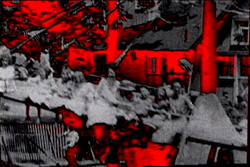 enlarged, frozen, played in slow motion, and colored. Here Jacobs is working not on an optical printer but on a computer, using a single shot that is a view of a large rotating swing full of merrymakers. The result is a movement back and forth between abstract images, representational ones, and combinations where we must struggle to see glimpses of bodies, signs, and walls. I found this theme-and-variations portion of the film to be a bit overlong, with some computer graphics seemingly used simply because they were possible. But there are extraordinary moments. The scene of the swing takes place in daytime, but in the middle section suddenly blackness, superimposed rain, and the sound of thunder transform the scene into a frightening nighttime storm through which the giant swing is dimly visible,continuing to carry its occupants on swoops and glides through the dark. Another passage, illustrated here, manages to suggest a flickering nitrate fire–another frightening moment in a different way.
enlarged, frozen, played in slow motion, and colored. Here Jacobs is working not on an optical printer but on a computer, using a single shot that is a view of a large rotating swing full of merrymakers. The result is a movement back and forth between abstract images, representational ones, and combinations where we must struggle to see glimpses of bodies, signs, and walls. I found this theme-and-variations portion of the film to be a bit overlong, with some computer graphics seemingly used simply because they were possible. But there are extraordinary moments. The scene of the swing takes place in daytime, but in the middle section suddenly blackness, superimposed rain, and the sound of thunder transform the scene into a frightening nighttime storm through which the giant swing is dimly visible,continuing to carry its occupants on swoops and glides through the dark. Another passage, illustrated here, manages to suggest a flickering nitrate fire–another frightening moment in a different way.
The more interesting parts of the film for me were manipulations of stereoscope-card images. By quickly alternating the right and left photos on the cards, Jacobs creates some remarkable effects of apparent motion. (David discussed a similar effect last year in his comments on Capitalism: Child Labor.) Even with only two camera positions represented on the cards, at times an illusion of continuous movement is created, especially in a dramatic shot of ocean waves. There are portions of the image where the water seems to be flowing right to left in an unstopping stream. In other shots the camera seems to be gliding in an arc around the subjects. Jacobs has been doing a lot of experimentation with creating an appearance of 3D using only regular film equipment and still photos, and I for one would have liked to see more of the stereoscope cards and a little less of the play with the Edison shot. But that’s just a quibble. It’s a fascinating film, well worth seeing.
A late addition to the program was the foreign-language Oscar winner Departures. Steve Jarchow, one of the heads of Regent Entertainment, is a Madison native, and he appeared after the film for a lively question-and-answer session. Regent has other forthcoming films in the festival’s schedule, including Tokyo Sonata, which we blogged about from the Palm Springs International Film Festival.
David will probably have something to say about Departures, which he saw last week in a theater in Hong Kong. (He warned us all to bring our tissues, since it’s a good, old-fashioned Shochiku tear-jerker, albeit with many amusing touches.) Steve’s answers to questions put to him by Emeritus Professor Tino Balio and the audience were equally interesting. At a time when Hollywood studios are closing down their art-film niche divisions and foreign-language cinema seems an endangered species, Steve’s company is providing a healthy counter-force. A relatively small firm, it can thrive on titles that bring in a few million dollars–chicken feed by studio standards. Apart from foreign-language titles, Regent is catering to the gay and lesbian market, both for films and television programming. Steve also re-confirmed something that we know well: that Madison is a great town for art cinema, one of the best outside the big metropolitan areas.
From Steven’s Q&A I went off to see Goodbye Solo, Ramin Bahrani’s fifth film, and his third since coming to  wider public attention with Man Push Cart. Roger Ebert has been a champion of Bahrani’s work, and we’ll be seeing his previous feature, Chop Shop, at Ebertfest in a few weeks.
wider public attention with Man Push Cart. Roger Ebert has been a champion of Bahrani’s work, and we’ll be seeing his previous feature, Chop Shop, at Ebertfest in a few weeks.
Goodbye Solo is set in Bahrani’s hometown, Winston-Salem, North Carolina. It deals with a genial Senegalese cab-driver who decides to befriend a prickly white man who he suspects intends to commit suicide. Beautifully shot, the film is to Winston-Salem what Collateral is to Los Angeles, and the final scene in the autumnal Great Smoky Mountains is gorgeous. It’s a moving tale, and one which manages to be emotionally uplifting without falling into the trap of solving all its characters’ problems and becoming a feel-good film.
For those in the Madison area, the festival continues today and tomorrow.
Dispatch from sunny Vancouver
Ballast.
After six days, plenty to report from the Vancouver International Film Festival. It has been unusually warm and sunny during our first week, but we have diligently spent most of our time in darkened theaters.
Kristin here:
Another country heard from
It’s a rare day when one gets to see a Haitian film. It’s an equally rare day when one gets to see a Jordanian film. On Monday I saw both, and the contrast between them could hardly have been greater.
Eat, for This Is My Body (Mange, ceci est mon corps, 2007), a Haitian/French co-production is Michelange Quay’s first feature. A Haitian-American, Quay received his MFA in directing at New York University.
The film’s opening is extraordinary, with a series of low-altitude helicopter shots beginning over the ocean and then moving rapidly across huge shanty-towns and finally into bleak mountain canyons in the country’s interior. After this passage of flight over bright landscapes, the bulk of the story takes place in and around a quiet, dark, nearly deserted colonial mansion somewhere in the countryside.
I’ve noticed that there seems to be a mini-revival of 1970s-style art cinema conventions. After many years in which art cinema tended to mean intricate psychological studies, a more challenging, formalist avant-garde seems to surface now and then. While watching Eat, for This Is My Body, it occurred to me that it could almost have been called Haiti Song, so strongly did it remind me of Marguerite Duras’s India Song. There enigmatic actions, often dancing, were staged in a colonial house. Eat, for This Is My Body’s action is, if anything, more enigmatic, though in this case the native population is present in the house in the person of a dignified manservant and a group of nine boys brought at intervals into the house, apparently as a treat.
The story is so minimal as to be non-existent. Apart from the nine boys, there are only three characters: an 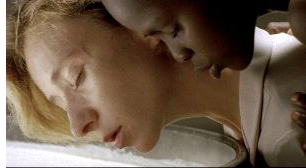 old woman, a young woman, and the black servant. Not until about 70 minutes into a 105-minute film are these characters identified, though only to the extent that the younger woman is revealed to be the daughter of “Madame.” There are hints of an erotic attraction between the daughter and the servant, though this comes to nothing. The daughter’s wandering through the local town, among the teaming population engaged in washing, selling, and other everyday activities suggests that she may be gaining some insight into native Haitian culture—but this, too, remains a mere hint. Ultimately, the film creates not a narrative, but an evocative narrative situation full of mystery. The film was shot on 35mm and creates a lovely, austere style for the scenes shot within the mansion.
old woman, a young woman, and the black servant. Not until about 70 minutes into a 105-minute film are these characters identified, though only to the extent that the younger woman is revealed to be the daughter of “Madame.” There are hints of an erotic attraction between the daughter and the servant, though this comes to nothing. The daughter’s wandering through the local town, among the teaming population engaged in washing, selling, and other everyday activities suggests that she may be gaining some insight into native Haitian culture—but this, too, remains a mere hint. Ultimately, the film creates not a narrative, but an evocative narrative situation full of mystery. The film was shot on 35mm and creates a lovely, austere style for the scenes shot within the mansion.
The Jordanian film, Captain Abu Raed (2007), takes a more familiar approach, centering around a likable, heartwarming protagonist. Raed, an airport janitor, finds an old pilot’s hat, and the children in his working-class neighborhood assume he really is a pilot. He plays along, less to feed his own ego than to inspire their imaginations through false tales of his adventures abroad. Gradually he becomes more involved in the lives of some of his listeners, and the film progresses from the sugar-coated tone of the opening scenes into a darker situation as Raed seeks a way to save the family of a violent neighbor.
Director Amin Matalqa was raised principally in the U.S., but he returned to his native country for this, his first feature. It is also the first feature film to come from Jordan in decades, and it reflects a slow but distinct movement into movie production in some of the Middle-Eastern countries where conservative religious views have long suppressed it. Captain Abu Raed is technically polished and makes considerable use of Amman cityscapes and ancient ruins as backdrops for the action. It’s also definitely a crowd-pleaser, judging by the sold-out audience I saw it with.
Another rarity is Australian director Benjamin Gilmore’s first fiction feature, Son of a Lion (2007), which he filmed entirely in the Peshawar region of Pakistan. That’s an area adjacent to the northwest border of the country with Afghanistan, notorious as a refuge for Taliban fighters and probably Osama bin Laden. The program lists Son of a Lion as an Australian/Pakistan production. I doubt any Pakistani funding went into it, but Gilmour wrote the script with the advice of the local people, and non-professionals play all the characters. The credits also contain quite a few Pakistanis performing tasks behind the camera.
The story seems inspired in part by the “child’s quest” narratives of the Iranian classics of Abbas Kiarostami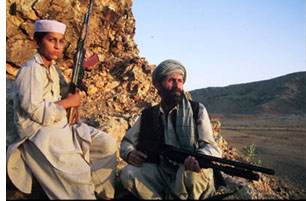 and Mohsen Makhmalbaf. A strict, traditionalist widower who makes guns wants his 11-year-old son to follow in the family business, while the boy longs to attend school. Apart from his father’s determined opposition, Niaz’s desires fly in the face of the local culture. Gun shops are everywhere, and every male adult seems to be armed. Shopkeeper casually step into the street to fire off weapons to test or demonstrate them. At one point the falling bullet from such random shooting kills a bystander. Between the personal scenes Gilmour intersperses occasional scenes of men sitting around and discussing the situation, debating whether they would shelter Bin-Laden if asked to or turn him in for the reward; they also speculate on America’s image of their part of the world.
and Mohsen Makhmalbaf. A strict, traditionalist widower who makes guns wants his 11-year-old son to follow in the family business, while the boy longs to attend school. Apart from his father’s determined opposition, Niaz’s desires fly in the face of the local culture. Gun shops are everywhere, and every male adult seems to be armed. Shopkeeper casually step into the street to fire off weapons to test or demonstrate them. At one point the falling bullet from such random shooting kills a bystander. Between the personal scenes Gilmour intersperses occasional scenes of men sitting around and discussing the situation, debating whether they would shelter Bin-Laden if asked to or turn him in for the reward; they also speculate on America’s image of their part of the world.
Son of a Lion was shot under difficult and dangerous circumstances on digital video (with post-production handled, amazingly enough, by Peter Jackson’s Park Road Post facility in New Zealand). The shots of the beautiful desert landscapes are not up to those we are used to from Iranian films, but they manage to suggest the grandeur of the area and to give a fascinating and humanizing insight into a region which the American government and media portray as merely a hotbed of terrorism.
Moroccan films are not quite as rare as these, but they’re certainly not common. As Burned Hearts (Morocco/France, 2007) was being introduced, I realized that the only other Moroccan film I had previously seen was by the same director, Ahmed El Maanouni. That had been Trances, a semi-documentary1982 film about a touring pop-music group. It was shown last year at the Il Cinema Ritrovato festival in Bologna, having been the first film restored by Martin Scorsese’s World Cinema Founda tion.
Burned Hearts was another film that seemed to transport me back to the 1970s art cinema. A young man returns to his childhood home after being educated as an architect in Paris. His tyrannical uncle is dying, and flashbacks present the painful memories evoked by the familiar sights and sounds of the city, this exploration of the character’s mental paralysis, along with the black-and-white cinematography of the locations, evokes both Duras and Antonioni. But El Maanouni refuses to concentrate solely on the hero’s concerns, bringing in several intriguing characters from the neighborhood and having groups spontaneously break into song and dance in the streets and shops.
Melodramas from Mexico
These films all come from regions seldom represented in international film festivals, but Mexican cinema 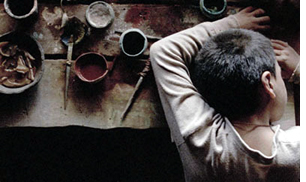 has had a growing presence in such venues in recent years. Two I’ve seen so far are very different from each other. The Desert Within (Desierto adentro, 2008), Rodrigo Plá’s second feature, already has a reputation after winning a cluster of prizes at the Guadalajara Film Festival. A period piece beginning in the late period of the Mexican revolution and extending into the 1930s, it tells the story of a peasant who inadvertently brings destruction on his village and decides that the only way to expiate his guilt is to drag his family far into the desert to build a church. The film takes a bitter view of Catholic guilt, with the protagonist forcing suffering, sexual frustration and death upon his children as his obsession grows.
has had a growing presence in such venues in recent years. Two I’ve seen so far are very different from each other. The Desert Within (Desierto adentro, 2008), Rodrigo Plá’s second feature, already has a reputation after winning a cluster of prizes at the Guadalajara Film Festival. A period piece beginning in the late period of the Mexican revolution and extending into the 1930s, it tells the story of a peasant who inadvertently brings destruction on his village and decides that the only way to expiate his guilt is to drag his family far into the desert to build a church. The film takes a bitter view of Catholic guilt, with the protagonist forcing suffering, sexual frustration and death upon his children as his obsession grows.
The other Mexican film, All Inclusive (2008), deals with another family crisis, but one which takes place over a few days in a luxurious resort on the “Mayan Riviera.” The story is slickly told by director Rodrigo Ortúzar Lynch and beautifully shot by Juan Carlos Bustamante, but I found the story forumulaic. A man who has just been told that he has only a short time to live, goes on vacation with his family, whom he has not informed of his condition. As he struggles with his secret, his wife and three children undergo their own crises. One daughter faces up to the fact that she is a lesbian, the son becomes entangled in an online “affair” with another man’s girlfriend, and the wife, assuming that her husband is being unfaithful, allows a young scuba instructor to seduce her—all this observed by the sardonic goth daughter.
As the tensions grow, a hurricane approaches, and the climactic set of revelations and reconciliations come just as it hits. During the narrative, each of the troubled family members manages to find someone gorgeous willing to bed them and/or hear their tales of woe. The idea that the bearish husband, seeking escape in a local bar, would run across a stunning 23-year-old Cuban woman who would take him into her home, listen at length to him, and finally, of course, teaching him to enjoy life. This gives him the courage to return to his family and tell them the truth. Once the family members have bared their soles, they become a jolly, well-adjusted bunch. It’s an entertaining story with likeable characters and touches of humor—but it’s a bit too much to believe.
Americans in Canada
Apart from Craig Baldwin’s Mock Up on Mu, which David will cover, I’ve seen two American indies so far. Momma’s Man (2008) is directed by Azazel Jacobs. It deals with Mikey, a man traveling on business who has problems with his flights and ends up staying with his parents in their New York loft. Finding excuses not to return to his wife and baby in California, he fritters away his time by reverting to his childhood pursuits. The film takes the daring step of being centered on an unsympathetic character who is the point-of-view figure for all but a few scenes. It manages to convey his gradual move from indecision to obsession and eventually a full-blown breakdown in a believable fashion.
Part of the appeal of Momma’s Man comes from the fact that Mikey’s parents are played by Ken Jacobs, the great experimental filmmaker, and his artist wife Flo Jacobs. It is set in their actual New York loft, a maze of odd filmmaking devices, accumulated pop-culture artifacts, and artworks. The two give extraordinary performances, managing to seem wise and caring and at the same time obsessive and eccentric to a degree that might have contributed to Mikey’s breakdown. Although Jacobs cast an actor as Mikey, one has to suspect that the film is at least somewhat autobiographical, and the casting of his parents has created a uniquely convincing portrait of a family.
David and I were delighted to see RR (2007) on the program. It’s the latest feature by American avant-gardist James Benning. Jim is an old friend, having been a graduate student in our department at the University of Wisconsin-Madison during our early years there. He has concentrated largely on landscape films, usually consisting of lengthy, static shots. This one consists wholly of distant views of trains in what appear mostly to be western and Midwestern locations. In virtually every case the shot holds until the entire train has moved through the shot or out of sight—or stopped, in a few cases.
As so often happens with structural films, small variations become evident to the alert viewer. A shot of a  car stopped for a train passing through a small town contains tiny reflections in the windows of a nearby house that may draw the eye. Some trains are covered with spray-painted graffiti, while others are pristine. One is led to speculate about what the cars may be carrying, and there is a hint of social comment in that activity. A considerable portion of most of the trains consists of tankers, presumably carrying the gasoline or other petroleum products that are currently causing so much trouble in our economy. Others contain numerous livestock cars, and one lengthy train contains nothing else. Among the views of many freight trains, we are treated to a glimpse of a single very short passenger train zipping through the briefest shot in the film.
car stopped for a train passing through a small town contains tiny reflections in the windows of a nearby house that may draw the eye. Some trains are covered with spray-painted graffiti, while others are pristine. One is led to speculate about what the cars may be carrying, and there is a hint of social comment in that activity. A considerable portion of most of the trains consists of tankers, presumably carrying the gasoline or other petroleum products that are currently causing so much trouble in our economy. Others contain numerous livestock cars, and one lengthy train contains nothing else. Among the views of many freight trains, we are treated to a glimpse of a single very short passenger train zipping through the briefest shot in the film.
RR draws us to enter into perceptual play, often with a distinct touch of humor. Few of Jim’s films have contained the measure of their shot length in their mise-en-scene so decisively. The length and speeds of the trains determine the duration of the shots, and one learns to watch for the number of engines pulling or pushing a train as an indicator of how long the train is likely to be. A few shots show trains moving slowly and decelerating at an almost imperceptible rate, teasing us as to whether they will stop altogether and whether the shot will end if they do. At times a train may move through the shot, only to reveal another on a parallel track. One shot plays a very clever game with us. I won’t reveal what it is, but the shot comes perhaps a third of the way through: an oblique view along a track with bushes prominently in the foreground and a short, arched underpass in the middle distance.
Jim has continued to shoot in 16mm in an increasingly digital age, and he consistently manages to make gorgeous images that look more like 35mm. The last one of RR, involving a vast wind farm, is a stunner.
Captain Abu Raed.
David here:
An unusually good VIFF, with many films to get your eyes open.
Enter the Dragons, with Tigers
As usual, the venerable Dragons and Tigers thread is offering some remarkable new films from Asia. The Good the Bad the Weird lived up to its reputation, not to mention its title, offering frenetic action and comic-book (in the good sense) bravura. Sell Out!, a Malaysian satire of corporate maneuvering and media brainwashing, doesn’t get points for subtlety—the goliath is called the FONY corporation—and sometimes it tries too hard. Still, it’s likeable enough, and the fact that it’s a musical adds a welcome bit of froth. The funniest bit, for me, was the opening parody of an art movie, which does actually get integrated into the main action.
Two late works by long-time Japanese directors offered a study in contrast. Kitano Takeshi’s Achilles and the Tortoise starts out sweet and ends very sour, not to say bitter. In telling the story of a boy whose spontaneous love of drawing is forced into narrow commercial channels, Kitano suggests that art is a racket. Across the decades, schools and galleries push the pliant, nearly comatose young artist to create a signature style. He is told to be original, but also he must harmonize with fashion and tradition. With a grim obstinacy he tries to fulfill what the business demands, and to the end he is still trying.
Achilles is less willful than Takeshis’ and Glory to the Filmmaker!, and it tells a more coherent tale, but their glum narcissism is still in evidence. The film cries out for an autobiographical interpretation: is the naïve filmmaker corrupted by exposure to international art cinema? Pictorially, there’s some confirmation of this: Kitano seems to have abandoned his early films’ ingenious use offscreen spaces and planimetric compositions. Like his hero, who can’t achieve artistic singularity, Kitano has become a surprisingly academic and anonymous stylist.
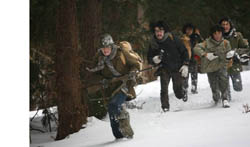 One can’t claim high originality for the style of Wakamatsu Koji either, but at least United Red Army has a gripping premise. The 1960s student movement was driven by opposition to the war in Vietnam and Japan’s cooperation with US policy, but in the following decade some factions emerged that were committed to violent revolution. Small cadres sequestered themselves in mountain cabins. Their exercises in “criticism and self-criticism” devolved into games of increasingly murderous aggression.
One can’t claim high originality for the style of Wakamatsu Koji either, but at least United Red Army has a gripping premise. The 1960s student movement was driven by opposition to the war in Vietnam and Japan’s cooperation with US policy, but in the following decade some factions emerged that were committed to violent revolution. Small cadres sequestered themselves in mountain cabins. Their exercises in “criticism and self-criticism” devolved into games of increasingly murderous aggression.
Wakamatsu’s technique is unstressed: No fancy angles, neverending tracking shots, or virtuoso compositions, just a businesslike application of today’s wobbly handheld look. The cunning lies in the film’s structure. After a half-hour montage summarizing the formation of the group, we are carried into the hideouts and watch the punishment grow more feverish and self-destructive under the domination of two leaders who seem parallel to Mao and Madam Mao.
By the end of the second hour, the remains of the army are on the run, struggling through vast snowy landscapes. Soon four survivors straggle into a ski lodge, hold the owner’s wife hostage, and face their final challenge: wave after wave of police assaults. Waiting for the inevitable outcome, the survivors spare time for grim humor: On 28 February one remarks, “I’m glad the all-out war won’t be tomorrow. Then my death anniversary could come only every four years.” And they can pause for an exercise in political discipline. After a lad takes an extra cookie, he criticizes himself. Stern reprimand follows: “That very cookie you ate is an anti-revolutionary symbol.” Unsentimental and unsparing, United Red Army is over three hours long, with not a longueur in sight.
A man parks his car to pick up some cake at a bakery. He has been away from home all night; now he’s rude to the lady behind the counter. Having bought a couple of cakes, he finds that a sinister black car has double-parked and hemmed him in. His efforts to find the owner lead to a spiral of comic and pathetic confrontations with an orphan child, burly Triads armed with whitewash, and a pimp with a distinctly bad haircut.
Creating something of a network narrative, Chung Mong-hong’s Parking in its modest way offers a cross-section of Taiwanese society, from the prostitute brought over from China to a jaunty barber who more or less controls the switch-points of the story. The ending will strike some as dovetailing all the cards a little too smoothly, but I found it satisfying, if only because it lets our haughty hero show unexpected resilience and compassion. This is only Chung’s second feature, but his work bears watching.
For once, it really is rocket science.
If you’ve already figured out the deep connections among Scientology, the aerospace industry, ritual sex magic, New Age spirituality, and the migration of Los Angeles hipsters to San Francisco in the 1950s, Mock Up on Mu won’t come as news. If, like me, you haven’t the faintest idea about the cat’s-cradle ties among these cultural phenomena, Craig Baldwin’s latest collage-essay-epic-lyric-narrative (all terms he applies to it) is the very thing you need. It’s as exuberantly peculiar as his earlier work like Tribulation 99 and Spectres of the Spectrum, flooding us with a relentless voice-over that splits off from and reconnects with the torrent of images grabbed from all manner of movies.
These earlier films had stories of a sort, swollen conspiracies and ominous coincidences that make Baldwin the eccentric cousin to Fritz Lang. But Baldwin says that these stories couldn’t really engage people, couldn’t get them to identify. Mu tells a more personalized tale. L. Ron Hubbard, founder of Scientology, has colonized the moon and sends Agent C to earth to arrange for people to be shipped up. Agent C runs afoul of Lockheed Martin, corrupt aerospace executive, and becomes attached to Jack Parsons, an early rocketeer who in the 1950s assumed the secret identity of Richard Carlson, so-so Hollywood actor. Meanwhile, Aleister Crowley rules a secret society at the center of the earth….
Or maybe not.
Actually, I won’t swear to much of what I just said. Baldwin’s phantasmagoria tests my memory, as well as plausibility. The story line is swallowed up by what he calls footnotes—swarming digressions, tangents, and flashbacks which are conjured up in imagery that shoots off in a dozen different directions. A few frames from a kiddie science movie or a grade-Z space opera, juxtaposed to Parsons’ rapid-fire account of the history of rocket testing, whiz by almost subliminally.
In any case, there are characters and a more or less linear story. But Baldwin is Baldwin, so things can’t be so simple. He has for the first time staged and shot footage of actors, and their scenes form a sort of string that you can follow. But just as crystals grow in fantastic array along a string, alien footage exfoliates out from the staged scenes. Baldwin aims, he says, at “a dialectical density.”
The result is a narrative experiment I’ve never seen before. With a simple cut, our characters are replaced by figures from other films, who become, in some spectral fashion, both alien inserts and our characters.
Confused? Here’s an example. Agent C (who will turn out to be Marjorie Cameron, muse of many West Coast artists) is riding with rocket scientist Jack Parsons. A series of shots shows them in the car’s front seat.
As the scene goes on, one character gets replaced by another.
Eventually both of our originals have been replaced.
The stand-ins can even change position as the dialogue continues uninterrupted (but always mis-synchronized).
The cuts make the inserted characters surrogates or avatars for our people, but they retain wisps of their original, enigmatic existence. They also remind us that situations like driving in a car are genre stereotypes, schemas so common that individual instances can serve as place-holders for one another. Yet the shots always return to the original actors, anchoring the associations and keeping at least one plane of the narrative moving forward.
These phantasmagoric shifts make the identity transformations in I’m Not There look labored. In Mock Up on Mu Baldwin may have found a new method of cinematic storytelling. Don’t expect Hollywood to pick it up soon.
Pulling half away
How do you tell your audience what it needs to know to understand what it’s seeing, and what it will see? A film can handle exposition (aka backstory) in several ways. Most films favor concentrated and preliminary exposition: Most information is given in one spot and quite early on. This is when you get the opening dialogue when characters say to one another: “Look, you’re my sister. You can tell me.” (Ohh…They’re sisters.) Concentrated, preliminary exposition is usually clunky, but it can be done with finesse, as in the opening soliloquy of Jerry Maguire.
The major alternative is distributed exposition, where information about the backstory is spread out, evenly or unevenly, across the film. This is common in mystery films (as when, under pressure, characters start to confess their relation to the murder victim) and in “puzzle films” like Memento, where we only gradually understand the relations among the characters. Delayed and distributed exposition in straight dramas is common in European art cinema, but it’s rare in the US, although independent films like Claire Dolan and Man Push Cart have made good use of the technique. Kristin already mentioned a similar strategy at work in Eat, for This Is My Body.
Lance Hammer’s Ballast comes garlanded with praise from festivals and major news outlets like the New York Times. For once the advance word is justified. I thought that Ballast was an exceptional intimate drama, focused almost entirely on three people and their layered relationships in a country town in the Mississippi Delta.
At this point I should mention how the three principals are connected, but part of the daring of Hammer’s film is to postpone, for almost an hour, telling you such things. He says he wanted a film that is, like the Delta, “spacious and quiet and slow.” Here the very issue of what we need to know is put into question. By blocking our knowledge of characters’ relationships, Hammer forces us to confront moments of action in a pure state. Each instant, each shot even, gains an integrity and gravity it wouldn’t have if we knew the full dramatic context.
Take the opening. After a brief, wordless prologue showing a boy in a field of crows, we’re in a vehicle pulling up at a bungalow.
The indistinct figure of a man goes to the door. Inside, a brief shot shows a black man’s face in silhouette.
Soon, the first man, who is white and weatherbeaten, is seen at the door, expressing concern for the man inside.
The white man enters, wrinkles his nose at a smell, and proceeds to another room, where a figure, turned from us, lies on a bed.
The black man continues to sit impassively before his TV, though now we can see his face more clearly.
Who are these men? What connects them? Who has died? An ordinary film would tease us with these questions but answer them fairly soon (say, in the next three or four scenes). Here, we will have to wait a considerable time to find out the answers. In the meantime, what we have registered in place of an action arc is the atmosphere of shock, sorrow, grieving, and lowering skies. And almost immediately a rather dramatic event will occur, nearly offscreen, and its causes will remain equally opaque for quite some time.
Ballast’s delay in spelling out its story premises is sustained by two unusually quiet main characters. Lawrence, the man sitting in the darkness, leads a solitary life and speaks reluctantly and briefly. Likewise, the boy James is often silent or alone. These two don’t soliloquize, and they live one day at a time. We must simply observe their behavior, try reading their minds, and more generally absorb the emotional tenor of their lives.
The sparseness of the exposition also puts us on the alert for any scrap of information that will fill in the blanks. For instance, references to “the store” flash out as clues to possible connections among the characters. Hammer’s strategy demands that the audience exercise a degree of patient concentration that most films never ask for.
For roughly the first half of the film, then, Hammer’s narrational technique creatively impedes our full understanding of the basic givens of the story. Once the relationships have coalesced (though there are still some revelations to come), the dialogue becomes more explicit and, some would say, the drama more traditional. But the visual narration continues to mute and elide dramatic moments. At some points pieces of action are rendered opaque by the bobbing, jump-cut camerawork. Most memorably, a clumsy embrace is hidden by a “wrong” camera setup, all the better to make us wonder about the impulses behind the gesture. Hammer matches his oblique plotting with an oblique visual style.
Hammer has cited Bresson as an inspiration, and in conversation he also mentioned late Godard, who has become willing to avoid exposition for nearly an entire film. Unlike Godard, who seems to revel in the pure artifice of withholding information, Hammer appeals to realism: The gradual piecing together of the narrative, he remarked to me, is like our coming to know people in life, bit by bit.
Correspondingly, by the end of Ballast we come to feel more empathy for Hammer’s characters than for Godard’s, and possibly even for most of Bresson’s enigmatic souls. But the empathy doesn’t come cheap, and it isn’t wallowed in. The climax is brushed past in one sideswiping shot; blink and you’ll miss it. In another interview, Hammer speaks of “putting something out and pulling half away.” By leaving us to fill in that half, Hammer exhibits his respect for his characters, and for his audience.
Mock Up on Mu
P. S. For dispatches from 2006 and 2007 editions of the VIFF, type Vancouver into our search box.
C is for Cine-discoveries
Funuke, Show Some Love, You Losers!
DB here:
Kristin and I think of Brussels as a gray city—gray skies, gray pavements, gray buildings, even gray, if often fashionable, clothes. It isn’t usually a fair description, though. In the twenty-plus summers we have been visiting, many days have been bright. I suppose our impression comes chiefly from one rainy fall we spent here in 1984, on a Fulbright research grant. Still, the public monuments bear us out, especially the Palais de Justice: except for its gold dome, it is gray, and has been encased in gray scaffolding for as long as we can remember.
Indeed, Brusselians assure us that the scaffolding will never go away because it’s holding the Palais up.
The gray motif continues this summer; during my visit, there have been almost no sunny days, just rain and chill. To prove that Belgians have stayed loyal to their favorite color, I took a shot of a new piece of public architecture near the Central Station: a half-circle of tipped-over pyramids that are, ineluctably, gray.
Still, the movies provide my light and color. I talked about Brussels as one of the great film cities in last year’s entry. I found further proof in a 2003 Marc Crunelle’s Histoire des cinemas bruxellois (in a series announced here), a small book with some fine pictures, one of which you will find at the end of this entry.
As usual, my host was the Royal Film Archive of Belgium. The archive offices remain in their splendid old building, the Hotel Ravenstein, but the new museum complex is still under construction. So the screenings continue to be held in the ex-Shell building, a piece of postwar Europopuluxe that I seem to enjoy more than most of the locals.
During my days, I watch films (very, very slowly) in the archive vaults; more about that project in my next entry. At night the event was Cinédécouvertes, the annual festival of new films that don’t yet have Belgian distribution. That festival, going back decades, has now been attached to a bigger event, the Brussels European Film Festival, which this year began on 28 June. BEFF showed thirty new titles, plus eight older items in open-air screenings, and it gave several prizes.
Kristin and I were in Bologna for Il Cinema Ritrovato and so I missed all of these, including the big Flemish film of 2007, Ben X. But Cinédécouvertes, running on during the BEFF, had its second and final week while I was in town. Films screened were competing for a 10,000-euro prize to be awarded to a distributor that would pick up the film. In addition, the venerable L’Age d’or prize would be awarded to a film that maintained the spirit of Buñuel’s scandalous masterpiece.
Herewith some notes on what I saw, and the prize results. Of course on the day I posted this, the sun came out.
Women, prep school, and manga
Cargo 200.
The two Iranian films in the program were earnest but varying in quality. Unfinished Stories (Pourya Azabayjani) is a network narrative following three women across a single night. A suicidal teenager doesn’t return home; her path crosses with that of a wife cast out by her husband; and she in turn brushes past a young woman who tries to smuggle her newborn baby out of the hospital. The situations are engagingly melodramatic, but the links among them (a footloose soldier, a compassionate taxi driver, an enigmatic old man) seemed to me forced, and as is often the case in these tales, the problem is how to conclude each story line in a satisfying way. The use of sound was very fresh, however. I especially liked the teenager’s obsessive replaying of taped conversations with her boyfriend. Often these “auditory flashbacks” are played over a black screen, and they come to exist as discrete, almost virtual scenes.
I like it when a film begins with a sharp, defining gesture, and Three Women (Manijeh Hekmat) had one. In close-up a car drives up to a tollbooth and the driver’s hand tosses a cellphone into a Charity Box there. Someone is on the run and cutting ties, but we won’t find out more for some time.
The first stretch of the movie concentrates on Minoo, a divorced professor and expert in Persian textiles. A rug dealer has promised to keep a precious carpet in the care of her museum, but he changes his mind and tries to sell it. In a fit of temper she grabs the carpet from its owner and takes it to her car, where her somewhat senile mother waits patiently for a trip to the hospital. Then the old lady vanishes. The emphasis shifts to Minoo’s daughter Pegah, who has set out on her own. The maddening Tehran traffic of the early scenes gives way to the empty quiet of the countryside. In the second half of the film, a favorite theme of Iranian cinema—the urban intellectual confronting rural life—is played out vividly when village elders debate whether to stone a woman who has had an abortion.
Like many of the best Iranian films, Three Women tells its story with dramatic force, offering robust conflicts and a degree of suspense rare in arthouse fare. Manijeh Hekmat, who made her name with Women’s Prison, manages the story threads skilfully, creating a continuous revelation of backstory and hints about how the tale will develop. I especially liked the way Minoo gradually realizes that she has had no idea how her daughter is living. As Alissa Simon points out in her perceptive review, Hekmat can spare time for a subtle composition as well. The ending came as a quiet surprise, deflating some dramatic issues but emphasizing the comparative unimportance of carpets, cellphones, and pop music in the face of the deeper problems facing Iranian women.
Add another woman and you have Adoor Gopalakrishnan’s Four Women. The quartet of stories, all adapted from literature and evidently set in the 1940s and 1950s, shows the fates befalling women in different roles, each identified with a title: The Prostitute, the Virgin, the Housewife, and the Spinster. Not much fun to serve in any of them, it turns out. The film has a sharp eye for details of local life and ceremonies, an ambition helped by the high-definition format: a slow-moving river is off-puttingly scummy. A little didactic and schematic, but it’s enlivened by a long sequence of a husband who methodically and endlessly eats everything put in front of him, with a seriousness he cannot bring to his marriage. The sequence starts in bemusement, moves to humor, and persists to the threshold of nausea.
The Argentine La sangre brota (Pablo Fendrik) was a little reminiscent of City of God in its relentless handheld assault on your senses, with the camera grazing faces and people racing in pursuit of drugs and money, with a beleagured taxi driver trying to do the right thing. La maison jaune (Amor Hakkar), from Algeria, appealed more to me. How much we owe neorealism! Quietly and simply, Hakkar tells of a father learning of his son’s death, fetching the body home for burial, and then trying to find a way to relieve his wife’s grief. So he paints his house yellow. Quiet and moving and not as simple, in story or pictorial technique, as it might sound.
Antonio Campos’ Afterschool (US) is a very assured first feature about drug-overdose deaths in a prep school. The story is told almost completely through the consciousness of Rob, an introspective and awkward freshman who indulges in internet porn. Passive to the point of inertia, Rob remains largely a mystery. This effect is often due to Campos’ bold use of the 2.40 widescreen frame, which often excludes some of the most important dramatic information. People are split by the left or right edge, or are decapitated by the top frameline, so we must strain to listen to the conversation and catch glimpses of the characters. This may sound arbitrary, but Campos finds ways to motivate the lopped-off compositions. One shot, when the parents of dead students record their thoughts on video, is one of the strongest pieces of staging I’ve seen this year. Unlikely to get U. S. theatrical release, if only because of its pacing, Afterschool marks Campos as definitely a director to watch. It won one of the two top Cinédécouvertes prizes.
The other top prizewinner was Yoshida Daihachi’s Funuke, Show Some Love, You Losers! It’s another insane Japanese family movie—that is, the family is insane, and the movie acts the same way, out of sympathy or contagion. After the parents are killed trying to save a cat from an oncoming truck (nice overhead shot of bloody skid marks), a new household takes shape. There’s the phlegmatic brother Shinji, his maniacally cheerful wife, his adolescent sister Kyomi, and his sister Sumika, who comes to stay after failing to make it in Tokyo as an actress. Family secrets emerge. Sumika starts turning tricks and Kyomi draws violent manga inspired by Sumika’s adventures. The comedy turns blacker when Kyomi’s comic books become best-sellers and all the family problems regale the reading public. With some scenes shot in high-contrast video, as if they were TV episodes, and a climax that blends film and manga, panel by panel, the film’s style is as all over the map as the characters and their complexes. Good dirty fun from the title onward.
The L’Age d’or prize went, deservedly, to Cargo 200 from Russia. Another black comedy, but one that gets blacker and less funny as it goes along, it becomes sort of a post-Glasnost’ Last House on the Left. (Seriously, maybe there’s an influence of Saw and Hostel here, with hints of Faulkner’s Sanctuary.) Set in 1984 and stuffed with retro clothes, hairstyles, and music, the plot spins crazy-eights around the corpse of a returning Afghan war hero; a teenager trying to buy homebrew vodka; a bootlegger who keeps a Vietnamese refugee as an assistant; a small-town policeman with a penchant for voyeuristic sex; and a professor of dialectical materialism who wanders, blinking, in and out of the lurid plot twists. Director Alexei Balabanov, who did the pioneering rough genre picture Brother (1997), gives no quarter here.
Strength in simplicity
Albert Serra directs the three kings in El cant dels ocells.
My three favorites were all resolutely unfancy. Shultes, a Russian item by Bakur Bakuradze, is a minimalist study of a pickpocket. Shultes lives with his mother, gives some of his loot to his legit brother, and takes up with a boy whom he tutors in thievery. At slightly over 200 shots, the movie is staged, shot, and cut with a precision that reminded me of Apichatpong Weerasethakul (Syndromes and a Century). On the inexpressiveness scale, Shultes, with eyes and mouth too small to fill up much of his face, makes Bresson’s pickpocket look positively other-directed.
 As with all movies about stealing, the pleasure lies in trying to figure out the plan and spot the telltale moves—sort of like the misdirection of a magic act. Here the drama is cunningly contrived. What is Shultes writing in his little brown book? Who is Vasya? What’s his big plan? The plot jumps a level when we realize that all we’ve seen is a flashback, and the ensuing conversation puts things in a startling perspective. Our blankly amoral protagonist even becomes a shade sympathetic. Too rigorous and unemphatic to be an arthouse import, I fear, but ideal for a festival.
As with all movies about stealing, the pleasure lies in trying to figure out the plan and spot the telltale moves—sort of like the misdirection of a magic act. Here the drama is cunningly contrived. What is Shultes writing in his little brown book? Who is Vasya? What’s his big plan? The plot jumps a level when we realize that all we’ve seen is a flashback, and the ensuing conversation puts things in a startling perspective. Our blankly amoral protagonist even becomes a shade sympathetic. Too rigorous and unemphatic to be an arthouse import, I fear, but ideal for a festival.
Shinji Aoyama is best known for Eureka (2000), which won a prize at an earlier Cinédécouvertes. Sad Vacation is one of those films that try to do justice to the ways in which humans become tangled in relationships based on acquaintance, momentary bits of kindness, and sheer chance. Kenji helps smuggle Chinese workers into Japan, but when one dies, Kenji takes the orphan boy under his wing. Soon characters and connections proliferate. There is the salariman and his dumb pal searching for the runaway Kozue. Kenji cares for a slightly daft girl, and he becomes romantically involved with the bargirl Saeko. Accidentally he finds the mother who deserted him, and he joins her new family, complete with mild-mannered father and rebellious brother. Always hovering around are several men and women who work for the father’s trucking company—people rescued, it’s implied, from crime or neglect.
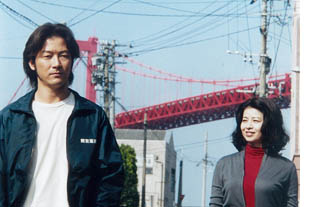 Aoyama manages the crisscrossing relationships delicately, without losing sight of the fact that behind Kenji’s laid-back appearance is a boiling desire to avenge himself on his mother. But she’s his match. A woman of smiling serenity, or smugness, she seems infinitely resilient. The final confrontation of the two, in a prison visiting room, has the giddy sense of one-upmanship of the prison visit in Secret Sunshine. Things turn grim and bleak, yet Sad Vacation manages to feel optimistic without being sentimental; even a flagrantly unrealistic soap bubble at the close seems perfectly in place. I notice that Aoyama has made nearly a film a year since Eureka; why aren’t we (by which I mean, I) seeing them?
Aoyama manages the crisscrossing relationships delicately, without losing sight of the fact that behind Kenji’s laid-back appearance is a boiling desire to avenge himself on his mother. But she’s his match. A woman of smiling serenity, or smugness, she seems infinitely resilient. The final confrontation of the two, in a prison visiting room, has the giddy sense of one-upmanship of the prison visit in Secret Sunshine. Things turn grim and bleak, yet Sad Vacation manages to feel optimistic without being sentimental; even a flagrantly unrealistic soap bubble at the close seems perfectly in place. I notice that Aoyama has made nearly a film a year since Eureka; why aren’t we (by which I mean, I) seeing them?
Some films, like those of Angelopoulos, seem to spit in the face of video. You can’t say you’ve seen them if you haven’t seen them on the big screen. Such was the case with my favorite of the films, The Song of the Birds (El cant dels ocells, 2008) by the Catalan director Albert Serra. It merges an aesthetic out of Straub/ Huillet—black and white, very long static takes, drifts and wisps of action—with a joyous naivete recalling Rossellini’s Little Flowers of St. Francis. Serra’s film also reminded me of Alain Cuny’s L’Annonce fait à Marie (1991) and one of the greatest of biblical films, From the Manger to the Cross (1912). All make modest simplicity their supreme concern.
We three kings of Orient are . . . well, definitely not riding on camels. We are in fact trudging through all kinds of terrain, scrub forests and watery plains and endless desert, to visit the baby Jesus. We are also quarreling about what direction to go, whether to turn back, and why we have to sleep side by side so tightly that our arms go numb. And in an eight-minute take we are struggling up a sand dune, vanishing down the other side, and then staggering up again in the distance.
The three kings aren’t characterized, and they are sometimes unidentifiable in the long-shot framings; only their body contours help pick them out. Intercut with their non-misadventures are glimpses of an angel (whom they may not see) and stretches featuring Joseph and Mary, who caress a lamb. Eventually the infant Himself puts in an appearance, burbling. When the kings finally arrive, one prostrates himself. The image settles into a tidy, unpretentious classical composition and we hear the film’s first burst of music, Pablo Casals’ cello rendering of the folk tune Song of the Birds.
The kings get a chance to bathe in a scummy pool before returning home. Off they trudge. “We’re like slaves!” one complains. In a final shot that would be sheer murk on a DVD, they swap robes and set off in different directions. Did I see them embrace one another? Did they murmur something? I couldn’t tell for sure. Night was falling and they were far away.
Like Casals’ cantata El Pessebre, The Song of the Birds gives us a Catalan nativity. The simplicity is genuine, not faux-naif, and the humility doesn’t preclude humor. Although the shots are quite complex, the spare surface texture invests a familiar story with a plain, shining dignity. Discovering films like this, which you will never see in a theatre and could not bear to watch on video, makes this ambitious festival such a worthy event. It maintains the heritage of one of the world’s great cinema cities.
Next up: A report on films I’m watching at the archive’s vaults on–no kidding–the Rue Gray.
The Metropole, Brussels, 1932.
Thanks to Jean-Paul Dorchain of the Archive for help in finding illustrations. And apologies to readers who came here and found only a stub earlier. An internet gremlin somehow purged the first version of this entry a few hours after it was posted.
I drink your Oscar promo

Kristin here–
A week or so ago, David and I were watching Keith Olbermann’s “Countdown” on MSNBC. As the tagline to one of the stories, Keith quoted, “I drink your milkshake!” David was puzzled and asked why that sentence was suddenly popping up all over the place. I reminded him that Daniel Plainview says that line in the final scene of There Will Be Blood—a film that both of us like very much. That was when I learned that “I drink your milkshake” had entered the buzz of pop culture.
On Saturday, February 9, the new Entertainment Weekly arrived, with a half-page story, “Shake, Shake, Shake,” by Gregory Kirschling, dealing with the milkshake-line phenomenon. (The piece doesn’t seem to be online yet.) Kirschling calls it “one of the strangest exclamations of film history.”
Why so very strange? Odd, maybe, but it makes perfect sense in context. It comes in the film’s final scene, set in the bowling alley of Daniel’s mansion. Naive preacher Eli Sunday has just told Daniel that he should buy a last bit of oil-rich land, whose owner had earlier refused to sell. Daniel replies that he has already extracted the oil from that plot.
The Milkshake Dialogue [Spoilers Ahead!]
Eli brings drinks and sits with Daniel near the bowling lanes, saying, “Mr. Bandy has passed on to the Lord.” He adds that William, Bandy’s grandson, wants to be an actor in Hollywood. Eli offers to help Daniel negotiate with William concerning the land: “Daniel, I’m asking if you’d like to have business with the Church of the Third Revelation in developing this lease on young Bandy’s thousand-acre tract. I’m offering you to drill on one of the great undeveloped fields of Little Boston.”
Daniel replies, “I’d be happy to work with you.” But he adds a condition: Eli must state that he is a false prophet and that God is a superstition. After receiving Daniel’s apparent agreement to financial terms, Eli reluctantly makes these statements over and over as Daniel insists that he speak more forcefully.
After Eli’s declaration, Daniel declares abruptly, “Those areas have been drilled.”
Eli, baffled, murmurs, “What?”
Daniel repeats, “Those areas have been drilled.”
Eli, as before: “No, they haven’t.”
Daniel: “Yes. It’s called drainage, Eli. See, I own everything around it, so, of course, I get what’s underneath it.”
Eli: “But there are no derricks there. This is the Bandy tract. Do you understand?”
Daniel: “Do you understand, Eli? That’s more to the point. Do you understand? I drink you water. I drink it up. Every day, I drink the blood of lamb [or land?] from Bandy’s tract.”
At this point Eli confesses how desperate he is, having sinned and lost his investments. Daniel taunts him viciously, saying that Eli’s twin brother Paul was the chosen one, having taken the $10,000 that Daniel had given him and started a small but successful oil company as a result. (The actual amount handed over in the one scene in which Paul appears was $500.)
Reverting to the subject of the Bandy tract, Daniel continues, “That land has been had. There’s nothing you can do about it. It’s gone. It’s had.”
Eli: “If you would just—“
Daniel, loudly, drooling: “Drainage! Drainage! Eli, you boy. Drained dry. I’m so sorry. If you have a milkshake and I have a milkshake—there it is. [He holds up his index finger]. That’s the straw, you see. [He turns and walks away from Eli] And my straw reaches acrooooooossssss [walking back toward Eli] the room … I … drink … your … milkshake. [He makes a sucking noise] I drink it up!”
Eli: “Don’t bully me, Daniel.”
At this point Daniel throws Eli down, begins hurling bowling balls and pins at him, and finally beats him to death.
The milkshake analogy isn’t all that bizarre. Daniel choses a metaphor for drainage that he thinks Eli can understand.
Beyond that, the milkshake speech is a way of emphasizing Daniel’s delight, not just in making a fortune in the oil business, but in doing so by paying little, or in this case no, money to those whose land he exploits. Stealing someone’s milkshake is a petty form of theft, so Daniel is able to trivialize the removal of oil that Eli has been counting on as his last chance for financial and spiritual salvation. The taunting also allows Daniel to revenge himself for the parallel earlier scene in the church where Eli had forced him repeatedly to confess how he had betrayed his own son. In this final portion of the film, Daniel no longer has any need to put on a friendly face, to pretend to have empathy with others.
Daniel mentions drinking water as well. He’s eating a cold, leftover piece of meat during much of this, and Eli is drinking whiskey. Eating and drinking are common motifs in the film, with elaborate discussions of how the rocky land of the Sundays’ ranch produces no grain but only supports goats. Upon Daniel’s arrival there, the family can offer him no bread but only milk and potatoes.
Thus I don’t think the milkshake line is out of place. That portion of the scene is, however, as Kirschling says, “weird, vaguely hilarious, and unsettling.”
By the way, according to a story in USA Today, director Paul Thomas Anderson derived the dialogue from “a transcript he found of the 1924 congressional hearings over the Teapot Dome scandal.” Sen. Albert Fall described oil drainage thus: “Sir, if you have a milkshake and I have a milkshake and my straw reaches across the room, I’ll end up drinking your milkshake.” He was convicted of taking bribes for oil rights on public lands.
Blenderized by the Internet?
Kirschling points out that the speech has spread far indeed. There’s a YouTube video, “There Will Be Milkshakes,” by Kevin Koonz (spelled Kunze in the EW and USA Today stories). There’s a website, “I Drink Your Milkshake.com,” which started as just a posting of the line and became a forum for discussing the film. The USA Today article declares the line “Hollywood’s Hottest Catchphrase.” There are various designs of T-shirts available on Cafepress and eBay.
It does seem odd that a line from a film that is an art-house favorite, with under $25 million grossed in the U.S. to date, should spread so widely. But these things happen.
The phenomenon doesn’t stop there, though. On February 8, Variety blogger Kristopher Tapley revealed that he and a friend had received courier-delivered milkshakes with an accompanying promotional flyer for the film. (Presumably Tapley himself is to be credited with the photos above and below. The small print in the lower one reads, “From Your Friends at Paramount Vantage.”)
Upon reading Tapley’s entry, David’s first reaction was, “Where can I get one of those milkshakes?” (I doubt they get delivered here in flyover territory, but the Dairy State can provide its own fine milkshakes.) My first reaction was, “I wonder how soon one of those promo fliers will show up on eBay.” (So far, none has. Just the T-shirts.)
[Added February 12: Apparently there is a hierarchy among the recipients of the Paramount Vantage promo. Tapley specifies that his milkshake came hand-delivered. On February 8, Peter Sciretta posted on the /film site the news that he received the same brochure, but his contained a coupon for a free milkshake (shown in a picture in his entry). He also reveals the brand involved: Cold Stone Creamery.]
Kirschling’s EW piece deplores this sort of thing: “The ironic, Internet-fast catchphrasing of a movie as rich and serious as Blood—and a performance as emotional as Day-Lewis’—is more than a little depressing. It reduces art to a punchline; it puts an epic in a blender and comes out with … a milkshake.”
True, in a sense. But great art has always been subject to humorous treatment and tends to come through unscathed. Marcel Duchamp stuck a mustache on a reproduction of the Mona Lisa and put it in a museum, and the act is considered a daring stroke of avant-garde art. The 1941 comedy Hellzapoppin’ contains a gag about the Rosebud sled from Citizen Kane. There are innumerable examples. The internet has accelerated such of manipulation of artworks and made us more aware of them, but it’s not new—and it is inevitable.
Indeed, the creators of the film don’t seem to be terribly upset. Paramount Vantage obviously seized upon the publicity opportunities, ordering high-quality milkshakes delivered like so many “For your consideration” ads. The USA Today article refers to the director’s reaction: “Not that Anderson minds—or worries that it will undermine the gravitas of the movie, which is up for eight Oscars, including best picture, director and actor. ‘I love the YouTube video,’ he says. ‘It’s completely insane and hilarious. It’s crazy what people latch onto.’”
Anderson is no doubt being polite about the video. It’s a typical hastily made mashup with randomly edited images from a trailer juxtaposed with Kelis’ 2003 song “Milkshake.” As Kirschling remarks, “How original!” But you have to believe that as a result of all the fuss quite a few more people will get intrigued and go to see There Will Be Blood than would have otherwise. They’ll certainly have to sit through the whole thing before reaching the moment they came to savor. And, knowing all of the above, I still was able to re-watch that final scene and find it as chilling as it was the first time through.















